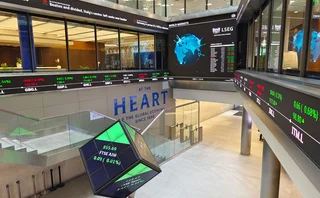
Currency derivatives house of the year: BNP Paribas
Risk Awards 2020: Bank seeks spot market insights to bolster forex options trading

At around 10pm in London on January 2, the yen began to fall. It dropped against the Turkish lira and then against G10 majors. Within minutes, the Japanese currency was in a nose dive, losing more than 3% against the dollar in roughly 30 minutes before rebounding.
Traders call it the witching hour – where both New York and Asian desks are thin, one heading home and the other just arriving – and with a public holiday in Japan, staffing was especially sparse.
At least one Hong Kong trader, already on their way in to work, rushed the final stretch to their desk. In London, Neehal Shah was dragged from bed to make the short trip to BNP Paribas’s Marylebone office.
Shah, the bank’s global head of G10 forex trading, could probably have stayed at home, as a potentially precarious situation was under control. The team had already laid the groundwork to handle unexpected events such as these, and when the dust eventually settled, the episode resulted in one of the most profitable weeks of the year for the G10 foreign exchange options desk.
“It was a great start to the year,” says Shah.
Their secret: hedge the options book based on liquidity insights from the spot market. On January 2, that meant recognising the drop had been caused by low volume and waiting for the market to rebound before hedging.
“Using the tools available to us, you could really see that the liquidity was extremely poor as spot was falling. If you tried to hedge into that event, you’re going to create significant slippage. As you see the market depth come back, and also the buy-sell pressure change, then you can potentially know this is a good time to actually hedge any deltas that you need to,” says Shah.
Using a broader range of data from the spot market to improve options trading seemed obvious to Shah, since options pricing uses historical spot moves to make assumptions about future volatility. The challenge came in how to visualise this information.
The bank created visual representations of spot trading data, which it now offers to clients within the algo suite on the Cortex Live single-dealer platform. The aim is to help clients trade around expected and unexpected volatility events, which punctuate otherwise relatively calm markets.
With flash crashes like these becoming a more common feature of the market, says Jon Spriggs, head of local market foreign exchange options, tools to quantify market liquidity are key for traders to be certain in their pricing. Currencies are trading in a low-vol regime, meaning stop-loss trades can easily build up outside the typical trading range and may exacerbate moves in either direction.
As you see the market depth come back, and also the buy-sell pressure change, then you can potentially know this is a good time to actually hedge any deltas that you need to
Neehal Shah, BNP Paribas
But those conditions can snap back to ‘normal’ relatively quickly, leaving a trading strategy developed for a falling market inadequate when that market starts to rise. “When you see market moves based on poor liquidity, there’s usually an element of mean reversion that occurs afterwards,” says Shah.
Take Friday, August 23, for instance. The bank’s tools allowed the trading desk to offer more liquidity around periods of uncertainty. After US president Donald Trump tweeted before noon eastern time criticising the Federal Reserve for speaking “without knowing or asking what I am doing, which will be announced shortly”, dollar-yen volatility ticked higher.
Traders looked to buy gamma, or the rate of change of an option’s exposure to spot moves, and dealers such as BNPP ended up with short gamma positions, says Shah.
The actual announcement, which came as a tweet after markets closed, stated plans to hike tariffs on certain Chinese goods from 25% to 30%.
Late-Friday timing raised the possibility of a gap in spot pricing on Monday morning. The tools helped BNPP understand they “should hold on to our positions from negative gamma as opposed to trading into the market”, says Shah.

When spot eventually moved higher, this decision proved correct. Throughout the event, BNPP was able to offer liquidity to clients, which it says is now common for the bank during volatility events – both expected and unexpected.
The key to understanding and pricing event risk, Shah says, is to focus on liquidity rather than volatility. Options traders need to know if moves in either direction will be sustained, and they can do that with insights from the spot market.
As both the buyer and a seller of an option can make money if the trades are hedged correctly, the trading strategy – and the tools used to devise and implement it – becomes more important than the historic realised volatility, Shah says.
BNPP is offering these insight tools to its clients, as a means of enhancing trading strategies through proprietary indicators such as buy/sell pressure and market skew, as well as liquidity measures like volumes, spreads and volatility.
“In a low vol environment, you expect nothing to happen, and when things do happen, you need to be able to react and respond quickly. You need to have information at your fingertips,” says Shah.
Available through its Cortex platform, the indicators and visualisations were intended for spot agency algo execution, but clients have asked for the insights independent of execution, says Joe Nash, global FXLM e-chief operating officer at BNP Paribas. One large real money client has also asked for direct connectivity through an application programming interface (API), which the bank is working on.
Swap points
Sustained low volatility has also driven the bank’s solutions for clients. Realised volatility in EUR/USD trades has been trending downward since late 2018, meaning some clients have focused more on swap points, the difference between the spot and forward rates, says Frédéric Han, deputy head of forex structuring at BNP Paribas.
“Swap points have been particularly volatile due to the rates movement, especially if you look at the swap points at the end of last year. They had reached a level that was historically high because of the rates differential between Europe and the US,” says Han.
Each side of the trade – dollar buyers (euro sellers) and euro buyers (dollar sellers) – have their own trading requirements in this scenario. For dollar buyers, the bank developed what it calls a flexi-swap lock, and for euro buyers, a dynamic hedging programme.
At the end of 2018, dollar buyers were looking for ways to lock in the swap points without locking in spot; swap points were at higher levels than usual and the market at the time expected the euro to appreciate. A flexi-swap lock allowed them to do so by locking in the swap points at elevated levels for a series of forwards on various spot values.

By separating the swap points from the underlying forex spot trade, the structure allows users “to think about the swap points on their own as a new underlying that they can hedge and then have this flexibility to take advantage of the opportunities in the market to lock in the right level”, says Nathalie Naffi, head of forex, local markets and commodity derivatives structuring at BNP Paribas.
The bank says it executed swap point trades in early January for medium-sized corporates in a “few dozen of million dollars”.
Against expectation, the euro failed to rise against the dollar, meaning the spot leg of the trade failed to produce anticipated gains. A corresponding decline in swap point levels has made the structure less attractive than when it initially traded, meaning activity has slowed.
On the other side of the trade, the swap point scenario meant euro buyers were losing out with the high cost of carry from trading forwards.
To address this issue, clients can hedge using a collar structure, which involves selling a call option to finance the purchase of a put option, limiting both losses and gains from movements in the underlying.
“If you do a collar, you open up a bit to FX risk, but you pay less carry by definition, especially if spot ends up being range bound,” says Han.
Sophisticated clients may alternate between forwards and collars to optimise their hedges. The bank is taking this approach a step further with the launch of a dynamic version of the strategy. Packaged into an index, the hedge simulates a rolling forward and rolling collar position – dynamically switching between the two based on the optimal outcome given market conditions. As of early November, the bank was in discussion with a few clients and awaiting their internal approval for the product.
Aside from optimising the hedge, a client’s operational burden is also reduced since it only needs one transaction with the bank rather than rolling the trade periodically, says Han.
Forex robots
BNPP has been busy building out the technology behind its linear forex derivatives business in the past year.
Using its existing automated pricing engine and natural language processing libraries, the bank developed a chat bot to automate execution in cash products via messaging platform Symphony, including non-deliverable forex forwards (NDFs).
The bot, which can respond to client price inquiries, execute and book trades without the intervention of the bank’s sales staff, is awaiting approval internally at BNPP and should be operational early next year, says Nash.
“The constraint there is actually the number of clients we have who can execute on Symphony,” says Nash. Most of their clients trade NDFs over Bloomberg, and the bank is working with the platform to offer a similar automated execution chat bot.
Symphony’s open architecture has made it popular with sell-side technologists looking to build chat-based tools, posing a direct contrast to Bloomberg’s comparatively closed systems.

Elsewhere in linear forex, BNPP introduced an algo for NDF trading, becoming one of just a small group of banks to offer such a service. Typically, execution algos in forex work best for large trades where the risk-transfer spread offered by a dealer exceeds the spread an algo could achieve by breaking up the ticket and sourcing liquidity throughout the various forex trading venues.
“In local markets FX, and particularly in non-deliverable currencies, the spreads are obviously much wider because there’s much more risk involved. Therefore, potentially in the algo space, there’s a lot more saving,” says Nash.
The algorithm, which investors can access on both multi-dealer platforms and BNP’s Cortex platform, went live in April and covers a variety of Asian currencies, including the Indian rupee, Indonesian rupiah and the South Korean won.
The algo sees around $1 billion in volume each month, accounting for roughly 5% of the bank’s overall NDF trading. Usage has grown from around $300 million a month when it initially launched.
Only users who have a paid subscription or are part of a corporate subscription are able to print or copy content.
To access these options, along with all other subscription benefits, please contact info@risk.net or view our subscription options here: http://subscriptions.risk.net/subscribe
You are currently unable to print this content. Please contact info@risk.net to find out more.
You are currently unable to copy this content. Please contact info@risk.net to find out more.
Copyright Infopro Digital Limited. All rights reserved.
As outlined in our terms and conditions, https://www.infopro-digital.com/terms-and-conditions/subscriptions/ (point 2.4), printing is limited to a single copy.
If you would like to purchase additional rights please email info@risk.net
Copyright Infopro Digital Limited. All rights reserved.
You may share this content using our article tools. As outlined in our terms and conditions, https://www.infopro-digital.com/terms-and-conditions/subscriptions/ (clause 2.4), an Authorised User may only make one copy of the materials for their own personal use. You must also comply with the restrictions in clause 2.5.
If you would like to purchase additional rights please email info@risk.net
More on Awards
Clearing house of the year: LCH
Risk Awards 2025: LCH outshines rivals in its commitment to innovation and co-operation with clearing members
Best use of machine learning/AI: CompatibL
CompatibL’s groundbreaking use of LLMs for automated trade entry earned the Best use of machine learning/AI award at the 2025 Risk Markets Technology Awards, redefining speed and reliability in what-if analytics
Markets Technology Awards 2025 winners’ review
Vendors jockeying for position in this year’s MTAs, as banks and regulators take aim at counterparty blind spots
Equity derivatives house of the year: Bank of America
Risk Awards 2025: Bank gains plaudits – and profits – with enhanced product range, including new variants of short-vol structures and equity dispersion
Law firm of the year: Linklaters
Risk Awards 2025: Law firm’s work helped buttress markets for credit derivatives, clearing and digital assets
Derivatives house of the year: UBS
Risk Awards 2025: Mega-merger expected to add $1 billion to markets revenues, via 30 integration projects
Interest rate derivatives house of the year: JP Morgan
Risk Awards 2025: Steepener hedges and Spire novations helped clients navigate shifting rates regime
Currency derivatives house of the year: UBS
Risk Awards 2025: Access to wealth management client base helped Swiss bank to recycle volatility and provide accurate pricing for a range of FX structures







